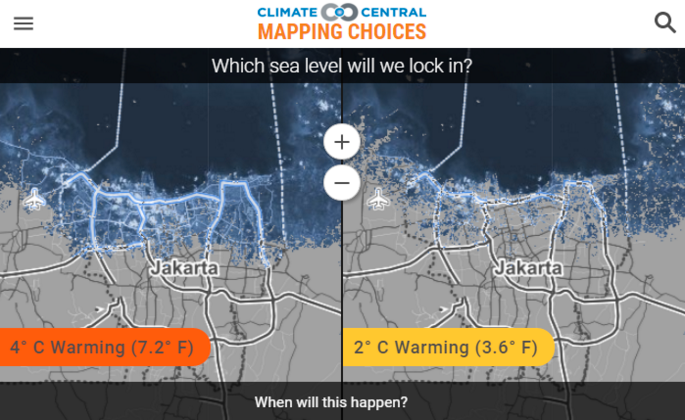Mapping Choices - Global
Surging Seas Mapping Choices is an interactive global online map that allows anyone to search for a global location and visually compare the local potential consequences of different emissions and warming scenarios. Users can view the long-term sea levels that different pathways could lock in and download map images or embed the map. Our goal is to offer a new way to essentially see the future, for every global city and postal code, and better understand what different emissions or warming levels ultimately mean. The sea level rise we map may take centuries to play out, but we set it in motion today.
Global Mapping Choices is based upon Climate Central-led research published November 9, 2015, which in turn builds upon our peer-reviewed scientific research published October 12, 2015 in the Proceedings of the National Academy of Sciences of the U.S.A..
New findings from these studies include:
-
Unabated carbon emissions leading to 4°C warming could lock in 6.9 to 10.8 meters (22.6 to 35.4 feet) of long-term global sea level rise.
-
Such rise would threaten to submerge land currently home to 470 to 760 million people on 6 continents, over the coming centuries.
-
Rapid and aggressive carbon cuts could decrease these threats by more than half, reducing the damage inflicted on many iconic global cities and landmarks.
-
For example, for China, deep global carbon cuts could prevent the submergence of land now home to 81 million people, as compared to unabated emission.

Science Behind the Tool
Mapping Choices is based on peer-reviewed scientific research led by Climate Central and published in the Proceedings of the National Academy of Sciences of the U.S.A. A separate report details mapping methods for areas outside of the U.S.
Carbon pollution casts a long shadow. It is expected to persist in the atmosphere long enough to prolong temperature increases for hundreds and thousands of years, long after we stop burning fossil fuels or clearing forests. Our research first translates cumulative carbon emissions into locked-in long-term global temperature increases, and then translates these into locked-in sea level rise projections.
The sea level projections are based on four separate models for the expansion of ocean water as it warms; melting glaciers; and the decay of Greenland and Antarctic ice sheets. We develop local projections that can vary by several feet from the global average based mainly on changing gravity fields as the polar ice sheets lose mass. (Local projections shown do not factor in the continuation of current land subsidence or uplift. In most places, these might translate to inches per century, but some places, such as southeastern Louisiana, are sinking closer to one foot per century.)
Some research has suggested that the West Antarctic Ice Sheet has begun an unstoppable collapse, but the evidence is far from conclusive. The maps in Mapping Choices do not assume inevitable West Antarctic collapse. If collapse has in fact begun, all locked-in sea levels would be higher than shown. Carbon emissions levels would still influence all outcomes. These scenarios of inevitable collapse are detailed in the PNAS paper.